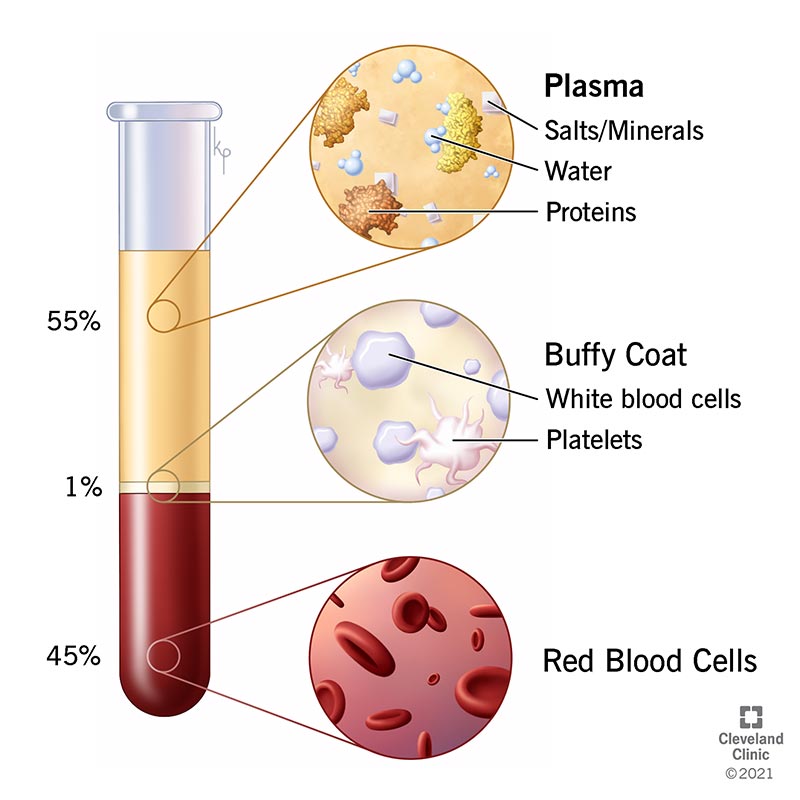Plasma is the liquid component of your blood that contributes to 55% of your blood’s total volume. Plasma is necessary to help your body recover from injury, distribute nutrients, remove waste and prevent infection, while moving throughout your circulatory system.

Plasma is the liquid component of blood. Red and white blood cells and platelets float in your plasma, and together make up whole blood. Your body contains between 5 to 6 quarts (5 liters) of blood.
Cleveland Clinic is a non-profit academic medical center. Advertising on our site helps support our mission. We do not endorse non-Cleveland Clinic products or services. Policy
Plasma has several roles to help your body function. Plasma is responsible for:
Plasma is essential to keep your body functioning. If you lose a lot of blood due to surgery, an accident or if you have a bleeding disorder, clotting or immune deficiency, plasma donations replenish the blood and plasma lost in your body.
There are two ways that you can donate plasma:
After removing plasma from your body, the lab freezes your donated plasma within 24 hours of removing it to preserve clotting factors and immunoglobulins. Frozen plasma has a shelf life of one year.
Plasma from donors with an AB blood type is preferred because it does not have antibodies in it and can be given to any blood type recipient, but anyone can donate.
In the embryo, cells found in your umbilical cord produce plasma cells. After development, plasma proteins form in the soft tissue of your bones (bone marrow), liver cells, blood cells at the end of their lifespan and in your spleen.
Plasma is a liquid. It's a light yellow color and resembles the color of straw. Although plasma makes up more than half of your blood’s total volume, the color of red blood cells dominates the color of your whole blood.
Plasma makes up 55% of your blood’s total volume. Red blood cells follow at 44% of your blood’s volume, and a combination of white blood cells and platelets fill the remaining 1%.
Your extracted blood spins in a centrifuge machine (centrifugation), which separates the whole blood sample into several layers. The yellow, top layer is plasma and the bottom layer contains your blood cells (red and white) and platelets.
Blood plasma is a combination of:
Plasma contains several proteins including:
To ensure the safety of your blood sample, your healthcare provider will test your blood for transmittable diseases after removal. In the same process, your healthcare provider also tests your plasma for the same diseases including:
There are several rare conditions that affect blood plasma including:
Symptoms of plasma conditions include:
There are several tests to check the health of your plasma:
Treatments for plasma disorders vary based on the severity of the illness. Treatment includes:
You can keep your plasma healthy by:
A part of all cells in your body, the plasma membrane, also known as a cell membrane, is the wall that separates the interior of the cell from the exterior and outside environment. Your plasma membrane protects your cells and functions to bring nutrients into the cells and remove waste from the cells. Your plasma membrane also interacts with other cells via proteins that attach to the membrane.
Platelet-rich plasma is the combination of platelets and plasma to assist in healing and repairing injuries. Platelets are responsible for helping blood clot during an injury.
After withdrawing blood from your vein, a centrifuge machine separates your blood into layers by spinning it quickly, leaving plasma and platelets after removing red and white blood cells. Your healthcare provider injects platelet-rich plasma into your body to heal injuries including:
A note from Cleveland Clinic
Plasma is essential for your body to function and serves as the liquid that holds your red and white blood cells and platelets together. Plasma disorders are rare, but your donation of plasma helps others live healthy lives.
Last reviewed by a Cleveland Clinic medical professional on 04/27/2022.
Learn more about our editorial process.
Cleveland Clinic is a non-profit academic medical center. Advertising on our site helps support our mission. We do not endorse non-Cleveland Clinic products or services. Policy